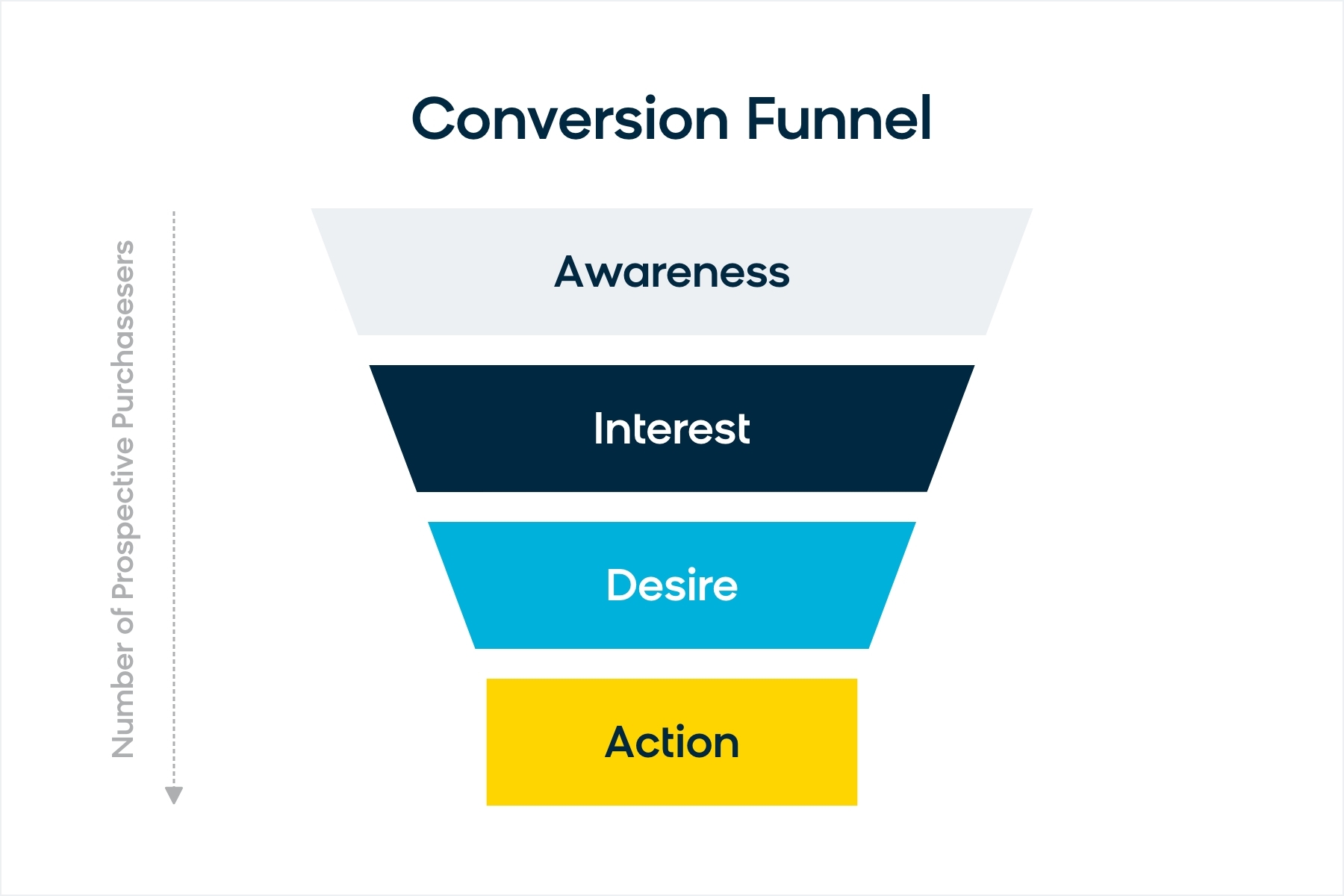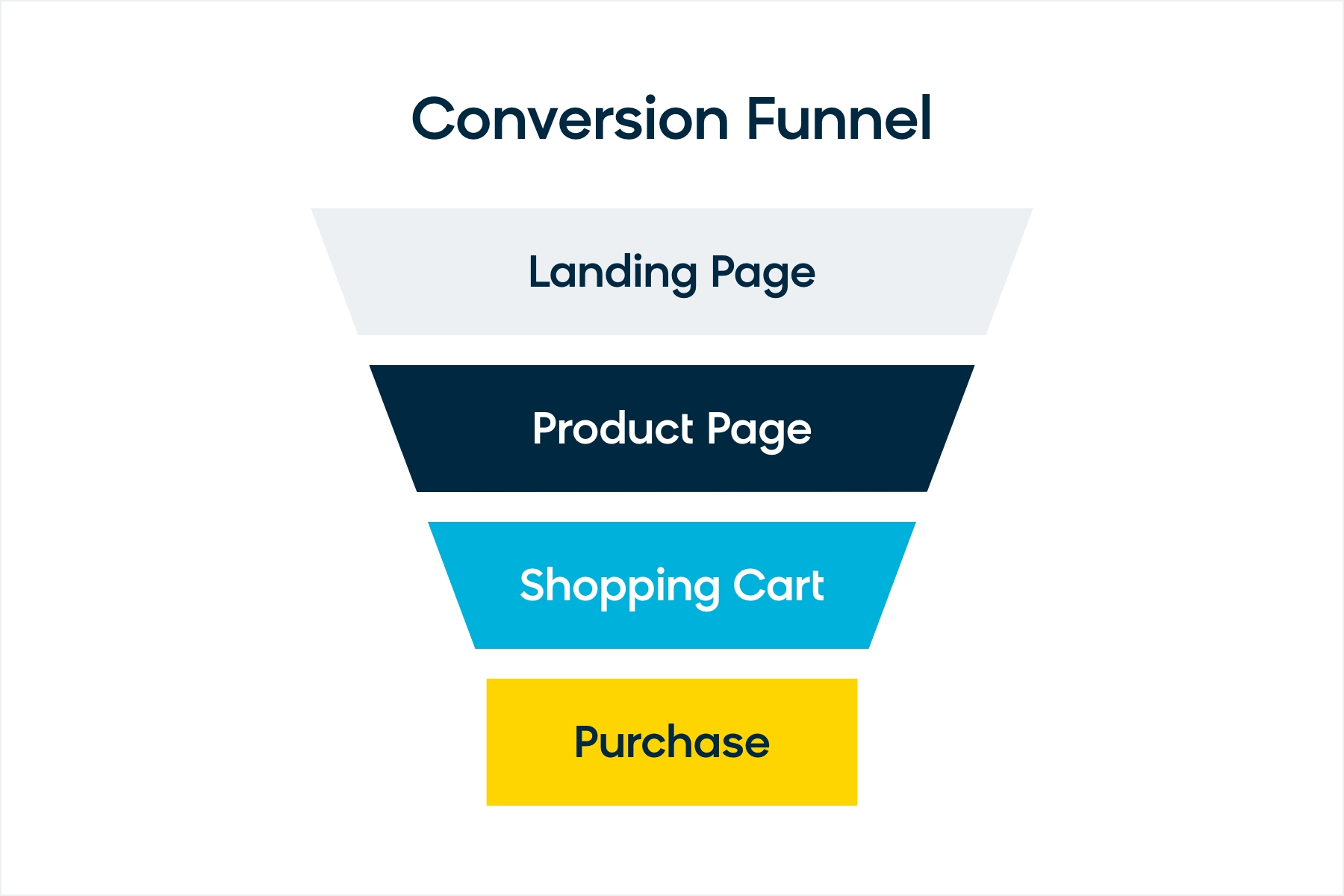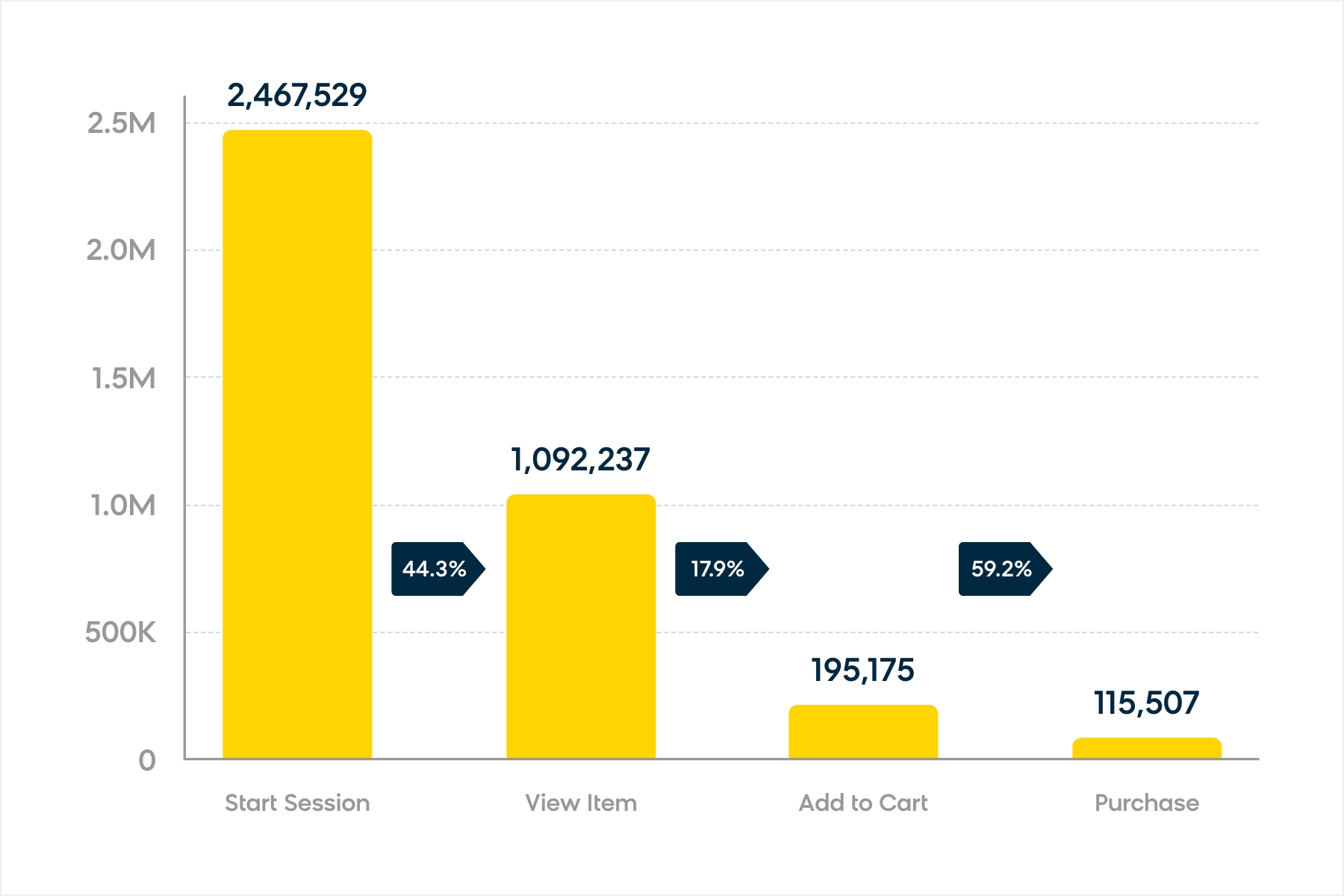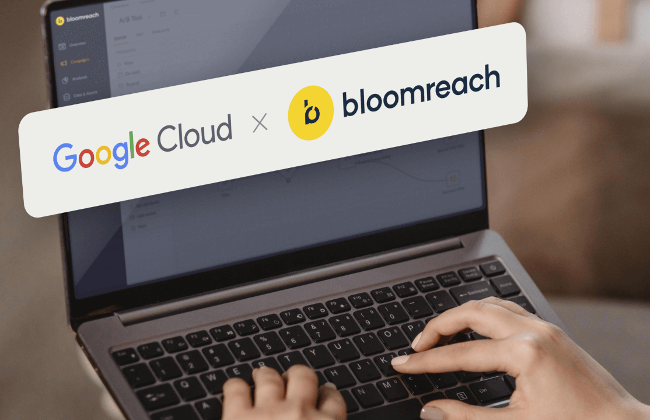E-commerce Conversion Funnel Analysis and Optimization Guide
By Samuel Kellett
06/30/2023
Conversion funnels are the roadmap that every marketer follows to reach their goals. But to really get the most out of your marketing efforts, you need to do more than put a blueprint into action.
Knowing the plan and maximizing the plan are two different things. That’s why marketers need to learn how to optimize and streamline their campaigns to produce the most effective conversion funnel for their needs.
The best way to improve your conversion funnel doesn't start with making changes: It starts with conversion funnel analysis and figuring out where those changes should be made. Digital commerce can be a puzzling space to navigate, especially when over 70% of customers are likely to abandon their cart instead of purchasing.
As a marketer, you need to know where and why issues like these are happening on your site. This article will teach you how to analyze your conversion funnels to find the most valuable touchpoints for your optimizations — one step at a time, starting with the basics.
What Is a Conversion (Sales) Funnel?
A conversion funnel (also known as a sales funnel, ecommerce funnel, or website funnel) is the path you design for a visitor to move through your site. It outlines each stage of your potential customers’ mindset when you are trying to influence them to engage with and purchase from your brand.

The funnel metaphor is an appropriate one, as you can see in the image above. For each stage, your audience gets smaller and more targeted as they get closer to conversion.
What Are the Steps of a Conversion Funnel?
No matter what your conversion goal is, there are four main stages to any conversion funnel: awareness, interest, desire, and action.
- Awareness Stage: The top of the marketing funnel is all about making people aware of your brand and capturing their attention. Implementing marketing efforts that make people conscious of your products, your site, and your company is the first step in nurturing a lasting customer relationship.
- Interest Stage: Once you’ve attracted potential customers to your site, you have to spark interest in your products. Relevant content, attractive visuals, and special offers are good ways to entice your visitors to engage with your brand further.
- Desire Stage: This step involves nurturing a relationship of trust and the desire to buy. Making sure your visitors receive a relevant, personalized customer journey will help pull your prospect further and further along the sales funnel.
- Action Stage: The final step to achieve your goal. Your visitors have passed through the conversion funnel and are engaging with your brand.
The beauty of this format is that it can be applied to so many things. No matter which marketing campaign or conversion goal you have, you can use a conversion funnel to organize your efforts. It’s a plan you can utilize to drive any action you are trying to get your users to take.
Do you need to grow your email list or expand your loyalty program subscriptions? Use a conversion funnel leading to an email address form or a loyalty sign-up form. Do you sell products on your website? Use a conversion funnel that carries users all the way from their first point of entry to the “thanks for purchasing!” page — here’s what a conversion funnel for this goal would look like:

Your conversion funnels can be as advanced as you'd like, and the more you optimize and fine-tune them, the more complex they can become. Your final version will likely be a lot more intricate than the one pictured above.
It doesn't matter what you call each step in the conversion funnel. It’s about addressing the specific stages of the customer lifecycle, plugging them into your funnel, and finding the ideal touchpoints to engage with your audience.
Read This Next: What Is Customer Lifecycle Marketing and Why Do Businesses Need Customer Lifecycle Management?
Why Are Conversion Funnels Important?
Conversion funnels aren’t just advantageous for marketers. They’re vital tools for creating the most user-friendly and worthwhile customer journey, ensuring potential visitors become repeat customers.
Without clear paths to follow, your site can become a confusing mess for users to navigate. Having defined funnels allows you to plan the best path to purchase for your target audience. Plus, with a clear and well-executed layout, you can effectively test and optimize your conversion funnels to work towards higher overall conversion rates.
Once you’ve decided which steps will be mapped into your conversion funnel, you can determine which of these steps are most in need of improvement. This method of breaking your customers’ paths into pieces makes it much simpler to find the problem areas.
How To Analyze Your Conversion Funnel Marketing
A conversion funnel analysis shows you which area of the funnel needs work.
It gives you insights into what percentage of users make it from one step to the next, so you can find and improve the non-converting stages through conversion funnel optimization.
Here’s a step-by-step breakdown to help you analyze your marketing funnel, with examples to illustrate the process and best practices:
Take a Top-Level Approach
First, you need to find the main problem areas before you zero in on specific interactions. To do this, it’s best to run a top-level funnel analysis on the primary stages in your process. Let’s use the conversion funnel from the previous example above to see how this works in practice. The different stages we’ll be looking at are:
- Landing Page
- Product Page
- Shopping Cart
- Purchase
Now, let’s take a look at the engagement numbers for each conversion funnel stage and determine which stages aren’t channeling enough traffic towards your conversion rate. Are you seeing an unexpected drop before they even view an item? After they view one? Or are you losing potential buyers once they’ve added items to their cart?
Here’s a sample analysis of a top-level conversion funnel in Bloomreach Engagement:

Based on this example, if we evaluate 1,000 of the visitors entering the site:
- 443 of those visitors will view an item
- 17.9% of those 443 people (79) will then add an item to their cart
- Of the 79 who add to their cart, 59.2% will make a purchase (46)
For every 1,000 people landing on the homepage, roughly 46 of them will make a purchase, producing a 4.6% website conversion rate.
Now we look for problem areas. Which of these stages should we focus on in order to achieve the largest possible uplift in conversions?
In this case, the steps between adding an item to the cart and making the purchase stand out as an area in need of improvement. This problem stage is easy to identify based on the numbers: If only 59.2% make that final conversion, that means over 40% of our potential customers are slipping away.
As we mentioned in the beginning, 70% of customers abandon their cart. So 40% cart abandonment isn’t bad, but how can we make it even better?
Dive Deep Into the Specifics
Now that we’ve found the primary stage we want to work on, we can take a closer look at these precise conversion points. Examining each specific step taken between adding an item to the cart and purchasing will help you identify which need the most improvement.

In the more detailed, step-by-step breakdown of the customer journey shown above, we can see that nearly 90% of visitors that added an item to their cart visited the cart afterward, so that step is performing well. And once someone has entered their personal details, there’s a strong likelihood that they will make it all the way to a purchase and reach the “Thank You Page.”
But there is a considerable drop-off between the steps of visiting the cart and entering personal details. Nearly 30% of the people that make it all the way to viewing their cart are then leaving!
How To Optimize Your Conversion Funnel Stages
Judging by the conversion funnel analysis above, the personal details form is in need of improvement. Maybe there are errors in the form, maybe it’s the color choice, or maybe it’s just too long. The best way to find your answer and optimize your funnel stages is to A/B test.
A/B testing starts with an informed guess — you make a hypothesis, then try to disprove it. If you try to prove it, you may run into confirmation bias. Instead, aim to disprove your hypothesis. If you can’t, then you’ve found the problem.
Let’s walk through an example of how you could address the drop-off from the personal details page from our conversion funnel analysis example.
We’ll start with a hypothesis: People are leaving the personal details form because of the form’s color.
You can test this hypothesis by creating several versions of the personal details form, each with a different color. And if you’re using Bloomreach Engagement, which has native and intuitive A/B testing and web personalization capabilities, you can simply create similar customer segments and serve each segment with a different color variant.
Read This Next: Customer Segmentation: Options Marketers Should Know
If all colors perform roughly the same, then your hypothesis is disproven and it’s time to formulate and test another one. If one color performs significantly better, test it again against different color variants. If it still performs better, then you have your fix — make the best-performing color the one you use on your site.
This A/B testing formula is the best way to fine-tune your conversion funnel. And like any good optimization process, the possibilities are endless.
Once you prove your hypothesis and improve the performance of your personal details form, you can move on to the next underperforming stage. Just repeat the technique until you’ve reached your performance goals across the board.
To recap, the general steps to optimize your conversion funnel are:
- Run a funnel analysis
- Identify the stage most in need of improvement
- Run a deeper funnel analysis on that stage
- Pick the step of that stage most in need of improvement
- Make a hypothesis about that step
- Try to disprove your hypothesis with A/B testing
- Repeat

Conversion (Sales) Funnel Optimization Best Practices
Besides the conversion funnel optimization steps outlined above, there are a few best practices that are good to keep in mind while you map out, troubleshoot, and improve your customer experience.
Make Your Site Easy To Navigate
Easy navigation is a concept that sounds intuitive and simple, but it’s important to take the time and plan out your customer journey. There should be a clear path for your visitors to follow from start to finish.
Make sure there’s an obvious and easy way for potential customers to get to your product pages, regardless of how they enter your site. And the path to your shopping cart should always be prominent while they’re navigating your pages.
Remember, people will abandon your conversion funnel at every stage for various reasons. Optimization is all about getting rid of the reasons for leaving that you can prevent or control. The more intuitive and user-friendly you make your site, the better your conversion rate will be.
Keep Your Stages Simple
Each step of your conversion funnel should be designed to provoke an action, whether your goal is to get an email address or drive customers to the purchase page.
Define the action you want for each step and make sure that your page doesn’t draw users away from that action. The busier you make your stages, the more distracting they become. Don’t lose sight of the ultimate goal.
Always Continue To Test
Test every change you make and push yourself to create hypotheses for other things you can test.
The limit to your testing is only limited to your hypotheses — nothing is too small to test. From colors and fonts to whole blocks of content, you can experiment and fine-tune your conversion funnel to get the best results.
Ecommerce Conversion Funnels — Key Takeaways
- A conversion funnel is a path you've designed for customers to follow through your site.
- Conversion funnels make your site easier to navigate. They also make it simpler to find problem areas to improve.
- When beginning your conversion funnel analysis, use a top-down approach: Start with the primary sections of the funnel, then drill deeper into the section that needs the most work.
- Make a hypothesis about the results of your analysis, then try to disprove it.
- Your site should be easy to navigate, your stages designed to provoke specific actions, and your testing continuous to make sure your funnels are delivering the most value.
Now that you know how to analyze and optimize your conversion funnel, you can start crafting next-level customer journeys across multiple channels that keep your audience coming back for more. Check out our blog on customer journey orchestration to learn everything you need to know about steering your audience towards the perfect products and enticing them to purchase.
Found this useful? Subscribe to our newsletter or share it.






